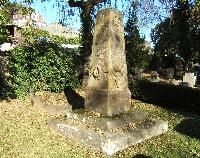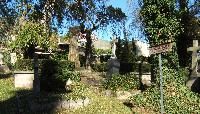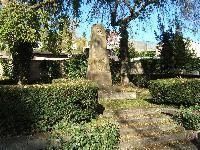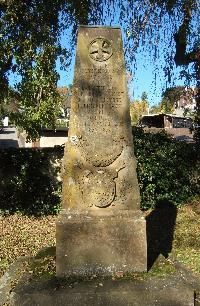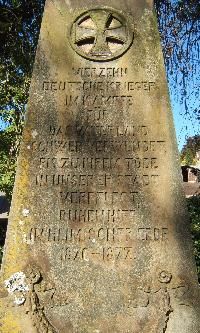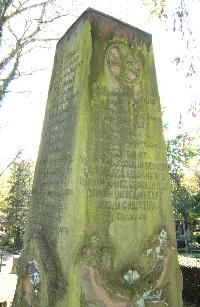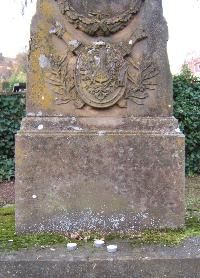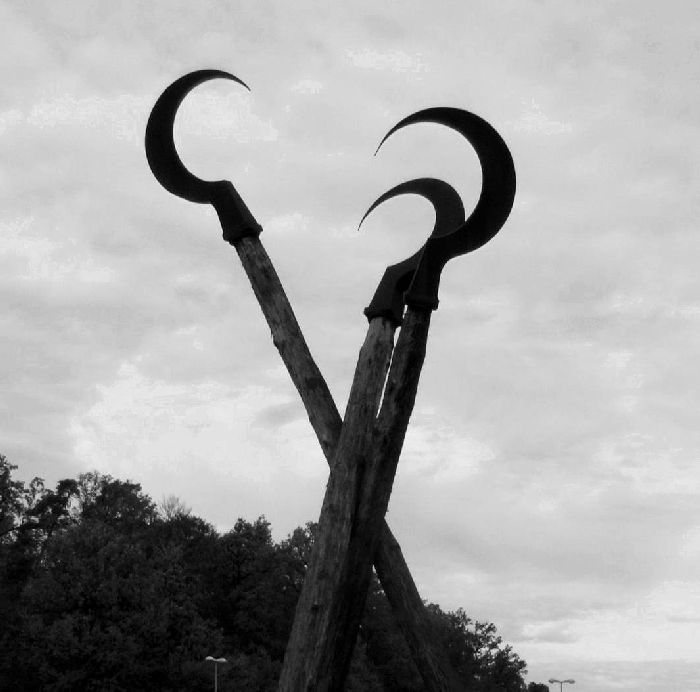Franco-Prussian War Memorial, Tuebingen
Pictures and text by Mark R. Hatlie
These pictures were taken on October 17, 2005, in the municipal cemetery at Tuebingen.
It commemorates fourteen German soldiers who died of their wounds while convolescing in Tuebingen during and after the Franco-Prussian war of 1870-1871. Memorials to this war are rare and Tuebingen is no exception in not setting aside a special monument for men from Tuebingen who fell fighting France. Now over 100 years old, the monument shows obvious signs of aging.
The war had been raging only a few weeks when the local chairman of the Sanitätsverein (a kind of local Red Cross organization) suggested that space be made available in the Tuebingen city cemetery for soldiers who died in local hospitals and have a monument built. There were two years of discussions about the form the monument should take before it was unveiled on 6 August, 1872 (the second anniversary of the battle of Woerth). The unveiling began with a procession at 07:00 from the city hall to the cemetery. Participants included Turnvereine(sports clubs), students from the Gymnasium (higher school), veterans, including current students at the University of Tuebingen, professors, civil servants, the fire department, and other citizens as well as the members of the Sanitaetsverein itself. There was music from a local choir, speeches and prayers, and the monument was consecrated under Catholic rites (despite Tuebingen being overwhelmingly Protestant).
Soon, veterans groups were dissatisfied with this. There was a wrought-iron slab in the main church down town (the Stiftskirche) which listed names of local killed, but it did not list all the names of Tuebingens fallen sons. (I have been unable to locate that list in the church itself. I suspect it no longer hangs.) They felt that the sandstone obelisk in the cemetery was more a gravesite than a monument of honor.
A Tuebingen-born sculptor living in Munich was given the contract to design something better. He submitted seven designs over the years up until 1912. The designs were for three different locations. The riding hall on Wilhelmsstrasse, the Holzmarkt (see the memorials now located there) and the current location of the Silcher memorial near the river Neckar.
In 1912, the artist who was responsible for approving a proposal, Konrad Lange, finally cancelled the project. He wrote, "Nor do I want to say anything about whether we need a war memorial at the present time, now that 41 years have passed since the great war, or whether we shouldn't wait until the next war, which does not seem to be long in coming, will again make it necessary to construct a memorial for Tuebingen's fallen sons."
He turned out to be right. Two years later, they did indeed have their war and eventually built a monument in the same cemetery.
Source: Hornbogen, Helmut: Der Tübinger Stadtfriedhof. Wege durch den Garten der Erinnerung. Verlag Schwäbisches Tagblatt: Tübingen, 19??.
